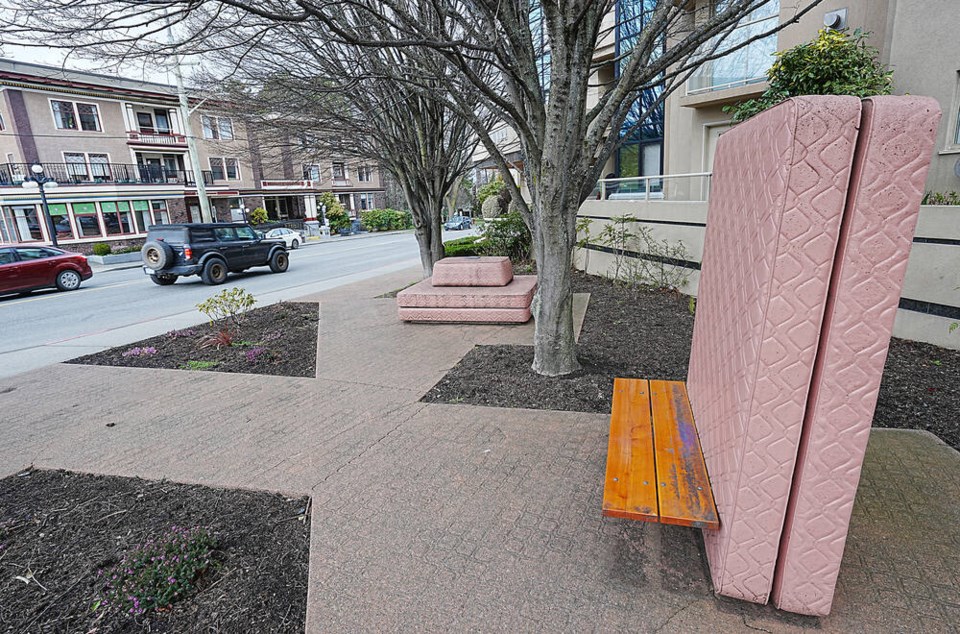Nothing gets our knickers in a knot like public art.
China can be accused of messing with our elections, Putin can mutter about nukes, and climate change can leave polar bears doing the backstroke amid the melting ice, and we just shrug.
But plunk a sculpture in an outdoor space where everyone can pass judgment on it, and even the Dalai Lama will curl his lip and start snarling and spitting like it’s a bike-lane debate.
Not, Peggy Elliott stresses, that she is complaining about the artistic value of the piece in question. What has Elliott and her neighbours concerned is the condition of the installation on their James Bay doorstep.
After a quarter century, the highly visible work at the confluence of Douglas and Blanshard, the one that includes the big Night is for Sleeping, Day is for Resting sign, has deteriorated, she says. Its pink concrete mattresses are covered in dirt, bird droppings and mould. The brickwork of the tiny city-owned patio is cracking, a tripping hazard. The planted areas get littered with cigarette butts, used needles and beer cans.
So Elliott has written the City of Victoria’s art in public places committee, asking for remediation of the site.
“No, we’re not trying to get rid of the art,” she says.
But yes, she does hear snarky comments from armchair critics passing by — though that’s nothing new for this controversial work. Just the prospect of it being installed led a 1995 letter-to-the editor writer to grumble, “If a five-metre-high sign spelling out ‘Night is for Sleeping, Day is for Resting’ counts as meaningful artistic statement, then anything does.”
That was nothing compared to the torrent that raged in 2003 when the public saw plans for Pavilion, Rock and Shell, the abstract piece that the same artist, Governor General’s Award-winner Mowry Baden, erected outside Save-On-Foods Memorial Arena.
Baden was hardly alone in having his public art pilloried by portions of the public. Jay Unwin’s marble Truth and Harmony was labelled “that block of cement with the bare bottoms” when it rose, moon-like, outside the Victoria police station in 1996.
Ten years later, an apparently abstemious letter-writer objected to the drink in the hand of the statue of late Swans Hotel owner Michael Williams (which yet another critic said looked like goggle-eyed Bubbles from Trailer Park Boys).
When Illarion Gallant won a 20-artist competition for a Bastion Square commission (Commerce Canoe, the aluminum boat suspended in five red-topped green reeds that now stands near the Johnson Street Bridge) a TC letter asked: “Was it a decision based on money saved or were the other 19 submissions that bad?”
If some people are left scratching their heads by conceptual pieces, others have had enough of folksy, life-sized human figures perched on benches, peering from bridges, going fishing with the dog, or whatever. “Makes my teeth hurt,” declared a 2010 letter reacting to the sweetness of so many statues.
That came after the unveiling of the Victoria Harbour’s The Homecoming, a bronze sculpture depicting a little girl rushing toward a returning sailor. (The writer might be buoyed to learn that dotting the internet today are photos of female tourists reaching back to shove the little girl in the face while tilting forward to thrust a breast into the sailor’s outstretched hand.)
Even the then-director of the Art Gallery of Greater Victoria weighed in on that one with an opinion piece in the TC: “Public art is a wonderful thing when done well and an embarrassment when it is not.”
OK, but who gets to decide which is which?
Everybody.
That’s the thing about public art. If you’re the artist you had better have a thick skin, because the whole world has an opinion about your work, one that’s probably going to be expressed more loudly, and bluntly, than is likely in one of those hushed-tone galleries where people in black turtlenecks drink white wine.
That’s particularly true if it’s the public that’s paying for the piece. Taxpayers went off their nuts in 1990 when it was revealed that the National Gallery of Canada had spent $1.8 million for Voice Of Fire, a painting consisting of nothing but three equally sized vertical stripes, two blue and one red. In 2014 someone from the National Gallery valued it at $40 million, but to many it still looks less like great art than the flag of some obscure former Soviet republic.
That’s OK. If people care enough to have a sense of ownership over their art, their town, their country, then let the passion flow, just as it did in the 1880s when Parisians recoiled at the sight of the Eiffel Tower rising into the sky. But don’t forget about the polar bears, too.




.png;w=120;h=80;mode=crop)
